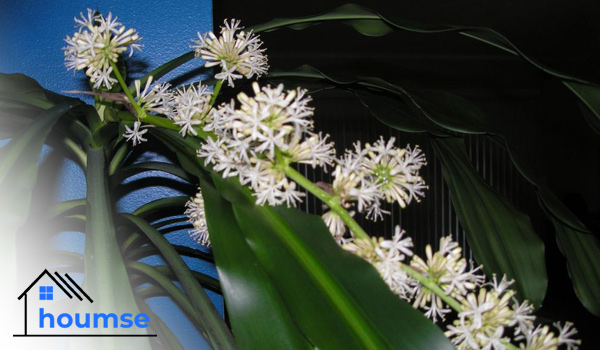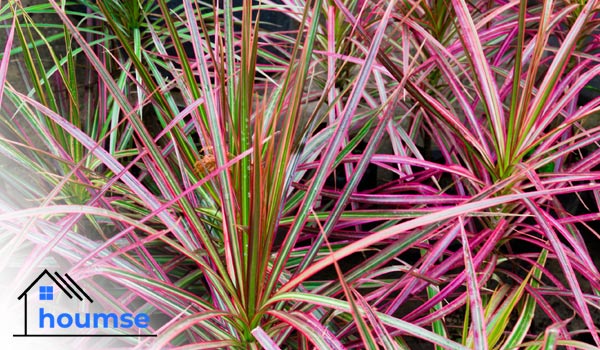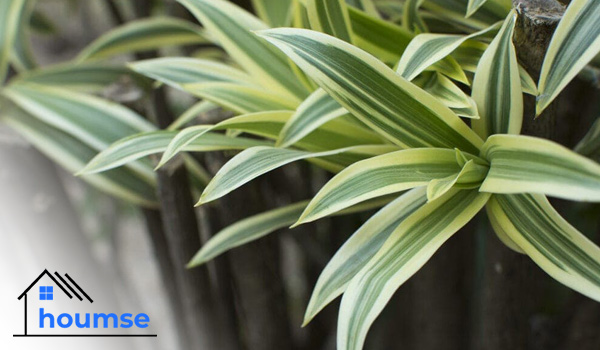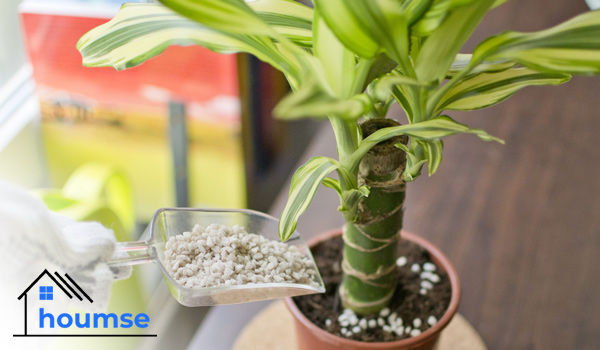Dracaena: Corn Plant Care Indoors (Full Guide)

Dracaenas have become very popular due to easy cultivation and care as well as striking ornamental leaves. But recently corn plants have attracted even more attention for an important reason: they can purify the air indoors and improve the environment.
Originally from Tropical Africa, dracaena is a resistant and very decorative plant with attractive features. It displays elongated leaves with different shades of green born at the top of its bare stems, which makes the corn plant resemble the aesthetics of the palm tree, a miniature one.
When growing a corn plant indoors in a container, it can reach considerable size, or you can regularly trim it to keep its dimensions compact. Depending on the conditions provided and how you care for it, you will have a branched or unbranched dracaena corn plant.
Below, you can find all the information you need about this species before buying one.
Dracaena Characteristics
The dracaena is a plant native to Madagascar, where it grows up to 13-16 ft, which is quite impressive. Indoors, however, corn plants are much smaller – they reach a maximum of 6.5 ft, although they usually measure 5 ft.
Also called the false palm or cornstalk dracaena, this plant can do more than create a focal point, as it can eliminate formaldehyde from the air, a dangerous compound found in almost every home. Other corn plants’ varieties have the same benefit too.
For example, Dracaena deremensis can remove trichloroethylene from solvents and varnishes, while Dracaena marginata (arguably the most popular type) absorbs xylene released from cigarettes and paints.
Corn plant flower is another charming feature of dracaena. It only blooms in its natural habitat, however, sometimes a plant grown indoors might bloom as well. Although it happens rarely, but when it does (in ideal condition and when the plant is older than 5 years old), you will be amazed by clusters of creamy-white blooms.
Corn plant flowers have a strong, sweet fragrance that reminds one of the scents of jasmine, lilac, honey, and freshly cut grass all at once. It blooms in the evening for about a month. The blooms drop at daylight, and another will open the following evening.

Corn Plants’ Popular Varieties
There are at least a few dozen types of dracaenas with different appearances, shapes, and sizes. Some of the most prominent are the following:
- Dracaena marginata: undoubtedly the most popular variety native to Madagascar. Also, the most appropriate for purifying the air indoors.
- Dracaena deremensis: This is a small species, which does not usually exceed 5 ft in height. It comes from East Africa and boasts beautiful green leaves with white streaks.
- Dracaena draco: Native to the Canary Islands, this type of false palm can live for many years and reaches large sizes.
- Dracaena fragrans: Also known as the trunk of Brazil, this specimen offers eye-catching leaves with a very intense green color and yellow streaks. It is a very easy plant to propagate by cutting. When grown indoors, it rarely blooms, but if it does, it will display beautiful, highly scented flowers.
Complicated Latin and Greek words aside, another popular method of distinguishing types of corn plants is to divide them according to their foliage:
- Bicolor: Varieties with yellow edges of the leaves.
- Tricolor: Varieties that have cream-colored stripes on the leaves with red edges.
- Colorama: Corn plants with green-red-pink leaves.

Corn Plant Care Indoor
Let us say you are going to get yourself a dracaena marginata. In this case, for proper care, think about its origin, which is the tropical forests of Madagascar with humidity climate and high temperatures. Your corn plant care should match these elements.
This specific variety aside, growing dracaena is convenient overall, and anyone should be able to handle it, even those without a green thumb. There are only three important rules:
- No cold temperatures
- No little water and high ambient humidity
- No direct sunlight
With that in mind, let us take a closer look are corn plant care and its requirements.
Corn Plant Watering
“How often to water dracaena corn plant?” has almost the same answer for various types of corn plants. Water your false palm at least once every 1-2 weeks – this period can be longer in winter. Keep in mind that too much water can damage the plant. Only the Sandera dracaena tolerates excess water in its saucer.
Corn plant watering is actually a key point for successful growing. After watering thoroughly (without making the leaves as well as the stem wet), pour the excess water away. This species may be able to handle occasional under-watering, but overwatering causes it problems. That is because dracaena roots have the capacity for retaining water.
If you tend to forget to water houseplants, and cacti are not your favorite, maybe this is the perfect plant perfect for you.
Corn Plant Soil
Generally, a dracaena corn plant prefers a slightly acidic, rich potting mix with good drainage. You can purchase a special soil mix for these plants at a garden center or online; It is a commonly used product and always available.
More experienced gardeners may want to create their own potting mix. To do this, you will need to combine sand, silt, and clay soil to have the proper loamy soil for growing your plant.
Dracaena Light Requirements
Corn plants are sensitive to direct sunlight as well as little light. If your plant is showing discolored foliage, it is a sign of too much light and sunburn. Therefore, it is best to locate cornstalk dracaena in a bright place near the window.
Nevertheless, this is a plant that adapts very well to conditions with dimmer light. That is why you may commonly see it in darker spots such as corridors. This is not ideal, but it will survive.
Temperature and Humidity
An indoor corn plant (home or office) enjoys temperatures between 59 to 77 ºF (68 to 77 ºF is the most ideal). That is why it is usually a species widely used to decorate workplaces.
It is also advisable to slightly increase the humidity around the dracaena with any possible means: humidifier, spraying, etc. In hot weather (above 77 ºF), also spray the leaves while keeping the plant away from direct sunlight.
Corn Plant Fertilizer
Using a balanced liquid fertilizer, feed your plant every other month during its growing season. In cold seasons, fertilize sparingly or not fertilize at all.
In corn plant care, you can even reduce feeding to twice a year with liquid fertilizer to provide the necessary nutrients. You can increase the dose if you notice that your green friend lacks a bit of shine.
Potting and Re-potting
In corn plant care, always go with large, high containers. This plant has a big root system and needs a lot of space for it. Palm pots are the best option, they are large and solid, creating the perfect conditions for them to grow.
Do not plant your small dracaena in a huge pot. But remember that the current container is not enough to keep a dracaena for many years. We recommend transplanting young corn plants which grow rapidly every two or three years into a pot one size larger.
Transplanting mature plants is not as necessary. All you have to do is replace the top layer of soil from time to time.

How to (Trim and) Propagate Corn Plant
Trimming is an important part of the corn plant care too. Spring and early summer are the best times for this, as the plant can recover quickly and new cuttings root faster in the prolonged bright light. This is how to trim a corn plant:
- Using a pair of clean, sharp pruners, cut 8 inches of the stem with four to six leaves from a cane of your dracaena. You can cut longer pieces from the cane if you want to reduce the size significantly. But do not worry, after a couple of months, the mother plant’s cane normally will re-sprout just below the cut.
- After making the cut, remove any excess leaves from the cutting and leave only four on it.
- The leaves later will provide the fuel for new roots to grow. If you have a very long cornstalk dracaena cutting, reduce the length so that about 4 inches of cane extends below the leaves. Do this by making an angled cut at the rooting end of the cane.
- Next, dip the cut end in rooting powder and place it into a pot of pumice, perlite, or coarse sand. Potting soil is not a good choice here since it retains too much water, resulting to stem rot before rooting. Now simply place the dracaena corn plant cutting in a bright location, away from direct sunlight until new roots appear.
- Keep the potting mix moist until the plant root, which normally takes about eight weeks. After this time, gently try to lift the stem. If you feel strong resistance, the cutting of the corn plant indoors has rooted and can be transplanted in its new pot with suitable soil. If the stem felt wobbly when lifting, give it more time to root.

Dracaena Pests and Diseases
Corn plant care may have some challenges as well. Some of the most common diseases of dracaena can be distinguished when keeping a corn plant indoors. This plant is vulnerable to diseases caused by inadequate irrigation and fertilization. However, the most common problem is too much water which results in root rot.
Brown spots on the leaves of the dracaena are a sign of placing it in an incorrect spot. For example, it may be receiving too much sunlight, hence the problems with the leaves. Simply change its location to solve the problem and it will heal almost instantly.
In addition to diseases. Pests, such as mealybugs, may attack the plants and find their ideal nest on the leaves. They must be removed as soon as possible using special products or home remedies like neem oil. Simply keep these tips in mind and you will never have to ask how to save a dying corn plant!
- In this post:
- Dracaena Characteristics
- Corn Plants’ Popular Varieties
- Corn Plant Care Indoor
- How to (Trim and) Propagate Corn Plant
- Dracaena Pests and Diseases



